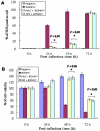Betanodavirus induces oxidative stress-mediated cell death that prevented by anti-oxidants and zfcatalase in fish cells
- PMID: 21991373
- PMCID: PMC3185053
- DOI: 10.1371/journal.pone.0025853
Betanodavirus induces oxidative stress-mediated cell death that prevented by anti-oxidants and zfcatalase in fish cells
Abstract
The role of oxidative stress in the pathogenesis of RNA nervous necrosis virus infection is still unknown. Red-spotted grouper nervous necrosis virus (RGNNV) induced free radical species (ROS) production at 12-24 h post-infection (pi; early replication stage) in fish GF-1 cells, and then at middle replication stage (24-48 h pi), this ROS signal may upregulate some expressions of the anti-oxidant enzymes Cu/Zn SOD and catalase, and eventually expression of the transcription factor Nrf2. Furthermore, both antioxidants diphenyliodonium and N-acetylcysteine or overexpression of zebrafish catalase in GF-1 cells also reduced ROS production and protected cells for enhancing host survival rate due to RGNNV infection. Furthermore, localization of ROS production using esterase activity and Mitotracker staining assays found that the ROS generated can affect mitochondrial morphology changes and causes ΔΨ loss, both of which can be reversed by antioxidant treatment. Taken together, our data suggest that RGNNV induced oxidative stress response for playing dual role that can initiate the host oxidative stress defense system to upregulate expression of antioxidant enzymes and induces cell death via disrupting the mitochondrial morphology and inducing ΔΨ loss, which can be reversed by anti-oxidants and zfcatalase, which provide new insight into betanodavirus-induced ROS-mediated pathogenesis.
Conflict of interest statement
Figures







Similar articles
-
Beta-nodavirus B2 protein induces hydrogen peroxide production, leading to Drp1-recruited mitochondrial fragmentation and cell death via mitochondrial targeting.Apoptosis. 2014 Oct;19(10):1457-70. doi: 10.1007/s10495-014-1016-x. Apoptosis. 2014. PMID: 25008790 Free PMC article.
-
Enhancement of reactive oxygen species metabolism by antioxidant enzyme Cu/Zn-SOD can block betanodavirus-induced necroptosis and suppress viral replication in fish cells.Fish Shellfish Immunol. 2025 Jul;162:110344. doi: 10.1016/j.fsi.2025.110344. Epub 2025 Apr 18. Fish Shellfish Immunol. 2025. PMID: 40254084
-
Betanodavirus up-regulates chaperone GRP78 via ER stress: roles of GRP78 in viral replication and host mitochondria-mediated cell death.Apoptosis. 2011 Mar;16(3):272-87. doi: 10.1007/s10495-010-0565-x. Apoptosis. 2011. PMID: 21170590
-
Understanding the interaction between Betanodavirus and its host for the development of prophylactic measures for viral encephalopathy and retinopathy.Fish Shellfish Immunol. 2016 Jun;53:35-49. doi: 10.1016/j.fsi.2016.03.033. Epub 2016 Mar 17. Fish Shellfish Immunol. 2016. PMID: 26997200 Review.
-
Betanodavirus: Dissection of the viral life cycle.J Fish Dis. 2017 Nov;40(11):1489-1496. doi: 10.1111/jfd.12638. Epub 2017 Apr 27. J Fish Dis. 2017. PMID: 28449248 Review.
Cited by
-
Are reactive oxygen species always detrimental to pathogens?Antioxid Redox Signal. 2014 Feb 20;20(6):1000-37. doi: 10.1089/ars.2013.5447. Epub 2013 Oct 26. Antioxid Redox Signal. 2014. PMID: 23992156 Free PMC article. Review.
-
Betanodavirus B2 protein triggers apoptosis and necroptosis in lung cancer cells that suppresses autophagy.Oncotarget. 2017 Oct 6;8(55):94129-94141. doi: 10.18632/oncotarget.21588. eCollection 2017 Nov 7. Oncotarget. 2017. PMID: 29212215 Free PMC article.
-
Vitamin E Supplementation Ameliorates Newcastle Disease Virus-Induced Oxidative Stress and Alleviates Tissue Damage in the Brains of Chickens.Viruses. 2018 Apr 3;10(4):173. doi: 10.3390/v10040173. Viruses. 2018. PMID: 29614025 Free PMC article.
-
Beta-nodavirus B2 protein induces hydrogen peroxide production, leading to Drp1-recruited mitochondrial fragmentation and cell death via mitochondrial targeting.Apoptosis. 2014 Oct;19(10):1457-70. doi: 10.1007/s10495-014-1016-x. Apoptosis. 2014. PMID: 25008790 Free PMC article.
-
Griseofulvin Inhibits Root Growth by Targeting Microtubule-Associated Proteins Rather Tubulins in Arabidopsis.Int J Mol Sci. 2023 May 12;24(10):8692. doi: 10.3390/ijms24108692. Int J Mol Sci. 2023. PMID: 37240033 Free PMC article.
References
-
- Ball L, Johnson K. Reverse genetics of nodaviruses. Adv Virus Res. 1999;53:229–244. - PubMed
-
- Bovo G, Nishizawa T, Maltese C, Borghesan F, Mutinelli F, et al. Viral encephalopathy and retinopathy of farmed marine fish species in Italy. Virus Res. 1999;63:143–146. - PubMed
-
- Munday B, Kwang J, Moody N. Betanodavirus infections of teleost fish: a review. J Fish Dis. 2002;25:127–142.
-
- Schneemann A, Reddy V, Johnson J. The structure and function of nodavirus particles: a paradigm for understanding chemical biology. Adv Virus Res. 1998;50:381–446. - PubMed
Publication types
MeSH terms
Substances
LinkOut - more resources
Full Text Sources
Medical
Molecular Biology Databases
Research Materials
Miscellaneous

